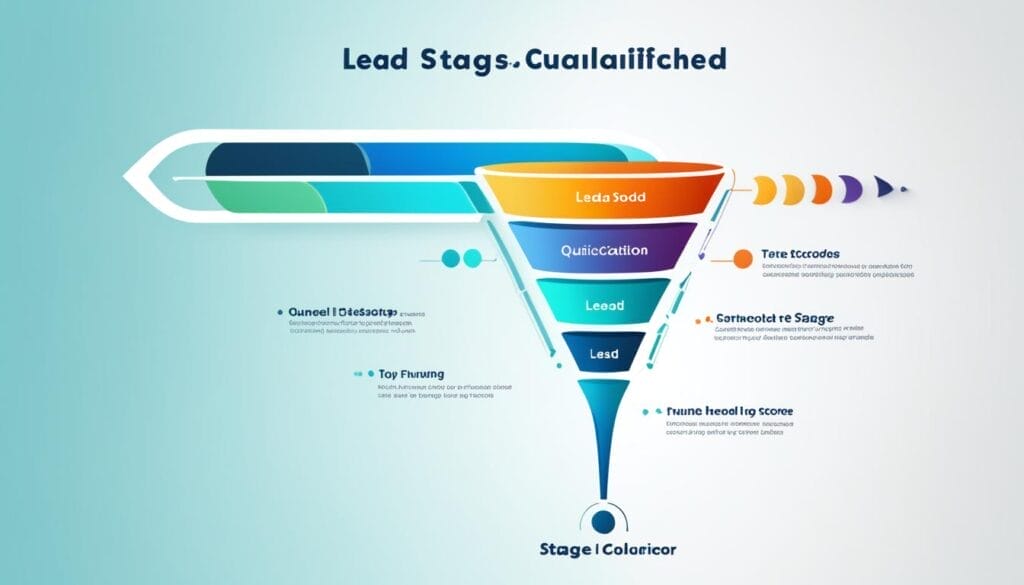Recent studies highlight how lead scoring boosts sales success. It makes teams focus on top leads, leading to more wins.1 Despite this, 99% of sales and marketing pros stick to old ways like the BANT method. But the BANT system is getting left behind by how buyers now make their choices.1 We will explore the advantages of using lead scoring and some great ways to enhance your system.
Key Takeaways
- Lead scoring helps prioritise the most promising leads, improving sales productivity and efficiency.
- The traditional BANT approach is outdated, as buyer behaviour has evolved beyond just budget, authority, need, and timeline.
- Effective lead scoring combines prospect demographic and behavioural data to accurately determine lead quality.
- Lead scoring enables better alignment between sales and marketing teams, with a mutually agreed-upon definition of a “hot” lead.
- Simplifying the lead scoring criteria, regularly evaluating the model, and collaborating between teams are key best practices.
What is a Lead Scoring System?
Lead scoring ranks one sales lead against another fairly. It matches the right follow-up with each inquiry.2 Marketing and sales experts use it to see where each potential buyer stands.2 Setting lead scores helps the marketing and sales teams work better together.2 By agreeing on what makes a lead high-quality, they can share more useful feedback.2 Also, it makes sure the top leads get quick attention. It does this by choosing leads with the most sales potential and readiness first.2
Objective Ranking of Leads
Aligning Follow-ups with Inquiries
Identifying Buyer's Journey Stage
Why Lead Scoring Matters
Companies now aim to do more with less in every aspect of work. This means working smarter to make the most of what they have. For example, marketing teams are flooded with leads. They hand these leads over to sales without checking which ones are worth pursuing first. As a result, the sales team often wastes time on leads that go nowhere. This approach leads to blame games and wasted effort. It makes the whole process less effective.1
Doing More with Less
Sales teams try to keep up with the flood of uncertain leads. But this just makes them less efficient. They aim to do more but end up achieving less.1
Prioritising Hot Leads
Many valuable hot leads are lost among the cold leads. This is a big problem. Sales teams should focus on the leads most likely to bring success. Yet, they often can’t find these key leads in time. By prioritising the right leads, sales teams can spot the best chances and act faster than others. This one change can greatly boost their success.1
Improving Sales Productivity

The Evolution of Lead Scoring Systems
Today, nearly all companies use the BANT method to classify leads. BANT stands for budget, authority, need, and timeline. If a lead meets these criteria, it’s seen as a good opportunity. This method has been the standard for over ten years. But over time, things have evolved.1
Changing Buyer Behaviour
Buyers now look for information early, before they decide on budget and timeframes. They read up on the latest tech and success stories. They also chat with others and check out social media. For most salespeople, it’s hard to see these steps.1
Implicit Behavioural Data
It’s harder for brands to catch buyers early in this changed journey. So, advanced lead scoring tools are adapting. They use all sorts of data to gauge a lead’s quality. This includes not just a lead’s job title or company sales. What also matters is how keen they are to make a purchase.1
While BANT used to be the go-to, it’s not enough. Modern systems now check out every move prospects make. They look at how people use websites, what they download, and how they react to ads. By doing this, they predict who’s really ready to buy.5
Understanding Lead Scoring Systems
Lead scoring is not just about ranking leads. It’s a connection between sales and marketing. They create a shared way to judge lead quality, action needed in sales, and work together across teams.1
Together, your marketing and sales can make a model for scoring leads. They decide what a top lead looks like. This makes sure your company values the best interactions or signs of keen interest.1
When everyone knows what is a top priority lead, then they can talk about when to send these to sales. It also helps decide which leads need more nurturing.1
Contract Between Sales and Marketing
Defining Lead Quality
Prioritising Quality Interactions
It also helps your company decide what lead actions show the most interest.1 This approach boosts the team effort between marketing and sales. It also ensures only the best leads are followed up on.1 Making the lead scoring rules simple and having the right sales and marketing folks help decide the rules make it work better.1

Creating a Lead Scoring Model
Prospect engagement is the other big part. This examines the prospect’s interest through actions like visiting your website.7
Prospect Identity
To define the prospect identity in a lead score, start by picking four or five key data categories. Next, decide how important each category is in relation to others. Give these a percentage ranking.6
Then, match each category with a set of criteria. Score them from A to D, with A being the best fit. This shows how well a lead matches the identity criteria.6
Prospect Engagement
For engagement scoring, select key actions that show a lead is more interested. Weight these actions by importance and recency.6
Ensure you’ve defined the importance of these actions in relation to each other. Then, rank the leads from 1 to 4 based on their level of engagement.6
Combining Fit and Engagement
Mapping Scores to Actions
This system ensures every lead is handled right. It helps in managing them in the best possible way.7

Lead Scoring Systems Best Practices
When looking at lead scoring, less is more, particularly at the start. If you use too many factors, it’s hard to see what’s really making a lead count.8 It’s crucial to have a team from sales and marketing decide on these factors. They need to review and tweak them every quarter. Also, work out what to do with leads at every stage, from starting a connection right through to sales.9
Keep It Simple
Think about how scoring can change the way people are paid. If marketing is judged just on getting lots of new contacts, they might miss the real best leads. This could stop them from meeting other important targets.9 Focus on using clear criteria and values. This makes a lead scoring model that’s clear and easy to keep up.3
Align Sales and Marketing
Focus on Standardised Data
Working with clear criteria and values helps you make a lead scoring model that works well and is simple to understand.3

| Lead Scoring Model | Key Components | Benefits |
|---|---|---|
| Demographic-Based Scoring |
|
|
| Behaviour-Based Scoring |
|
|
| Predictive Scoring |
|
|
Conclusion
So why delay? Start using lead scoring now and see your business take off. A good lead scoring system helps guess how much we’ll make. It also organises our sales process and uses our resources better.1 By mixing details about potential customers and their behaviour, I can pick the best leads for our sales team to focus on first.1 Keeping it simple and making sure sales and marketing work together is vital. Use clear, shared data for a lead scoring system that lasts.1
Lead scoring does more than sort leads – it’s a deal between sales and marketing. It sets rules on what makes a good lead, how to follow up, and teamwork between departments.1 Done right, I can make the most of our marketing and sales. This will help our business do really well.
FAQ
What is a lead scoring system?
A lead scoring system is like a game that ranks sales leads objectively. It helps pick the right approach for each lead. This system also tells us where a potential buyer stands in their decision process.
Why is lead scoring important?
It’s important because it helps sales teams focus on the best leads first. This makes them work more efficiently. It ensures that the most likely buyers get quick attention. Also, it makes marketing and sales teams work better together.
How has lead scoring evolved over time?
Old ways like BANT (budget, authority, need, timeline) don’t cut it anymore. Buyers now act differently. Today’s systems look at more data, such as how people behave online. This helps find the best leads more accurately.
What are the key components of a lead scoring model?
A successful lead scoring system pulls together what the prospect does and who they are. It sets clear rules, weights different factors, and links scores to actions to take.
What are some best practices for implementing lead scoring?
Make the system straightforward. Get sales and marketing to agree on the rules. Use clean, reliable data. Keep checking and improving the system. Using tools like Toplyne to do this work can make everything smoother.
Source Links
- https://www.oracle.com/uk/cx/marketing/what-is-lead-scoring/
- https://www.techtarget.com/searchcustomerexperience/definition/lead-scoring
- https://blog.hubspot.com/marketing/lead-scoring-instructions
- https://www.linkedin.com/pulse/lead-scoring-what-why-matters-purpleplanet
- https://www.dolead.com/growth-hub/lead-scoring-models-a-comprehensive-guide-to-boosting-sales
- https://learn.microsoft.com/en-us/dynamics365/customer-insights/journeys/score-manage-leads
- https://www.brevo.com/blog/lead-scoring-model/
- https://leadsbridge.com/blog/lead-scoring-best-practices/
- https://totalproductmarketing.com/blog/lead-scoring-best-practices/
- https://www.cognism.com/blog/lead-scoring






